High-Performance Second-Harmonic-Generation (SHG) Materials: New Developments and New Strategies
Cite this: Acc. Chem. Res. 2021, 54, 12, 2775–2783
Publication Date:May 27, 2021
https://doi.org/10.1021/acs.accounts.1c00188
Copyright © 2021 American Chemical Society
Abstract

Conspectus
Second-harmonic-generation (SHG) causes the frequency doubling of light, which is very useful for generating high-energy lasers with specific wavelengths. Noncentrosymmetry (NCS) is the first requirement for an SHG process because the SHG coefficient is zero (χ2 = 0) in all centrosymmetric structures. At this stage, developing novel NCS crystals is a crucial scientific topic. Assembling polar units in an addictive fashion can facilely form NCS crystals with outstanding SHG performance. In this way, our group has obtained many different NCS crystals with extremely large SHG intensities (>5 × KDP or 1 × KTP). In this Account, we first provide a brief review of the development of SHG materials and concisely highlight the features of the excellent SHG materials. Then, we present four facile and rational molecular design strategies: (1) Traditional BO33–-based crystals feature short absorption edges but usually suffer from relatively weak SHG performance (<5 × KDP). The combination of two types of pure π-conjugated anions (BO33– and NO3–) in a parallel fashion in the same compound has afforded a metal borate nitrate with a strong SHG effect. (2) To overcome the problems of the weak SHG effect and small birefringence in the less anisotropic QO4-based compounds, highly polarizable cations such as Hg2+ and Bi3+ are introduced into these systems, which greatly enhances both SHG effects and birefringence. (3) Iodate anions can be condensed into polynuclear iodate anions with a higher density of I5+ per unit cell, hence polyiodate anions can serve as excellent SHG-active groups. We developed a novel synthesis method for hydrothermal reactions under a phosphoric acid medium and obtained a series of metal polyiodates with strong SHG effects. In addition, as the number of iodate groups increases, the structural configuration of the polyiodate anion changes from linear to bent. (4) We introduce the concept of aliovalent substitution which features site-to-site atomic displacement at the structural level. Such aliovalent substitution led to new materials that have the same chemical stoichiometries or structural features as their parent compounds. Thus, aliovalent substitution can provide more experimental opportunities and afford new high-performance SHG materials. The introduction of a fluoride anion and the replacement of metal cations in the MO6 octahedron can result in new metal iodates with balanced properties including a large SHG effect, a wide band gap, and a high laser-induced damage threshold (LIDT) value. Finally, we briefly discuss several problems associated with the studies of SHG materials and give some prospects for SHG materials in the future.
